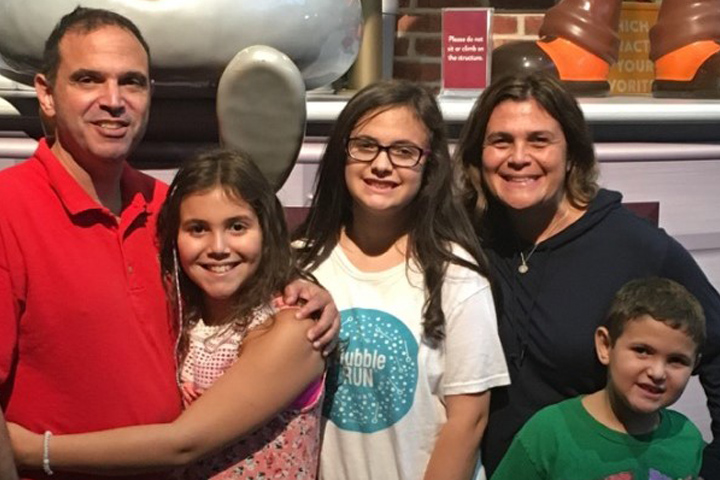Going Place-to-Place to Find the Treatments I Wanted

- Not able to have the Whipple procedure
- Chemotherapy with FOLFIRINOX, but seeking alternatives
- Stereotactic body radiation therapy, then NanoKnife surgery
- Post-surgical chemotherapy, and maintenance drugs
In January 2014, I began itching like crazy and my skin turned yellow.
I began losing weight and barely had the strength to hold my head upright. I retreated to my bed for 20 hours of the day, only rising to attempt a meal. I didn’t eat much.
Blood work revealed that my CA 19-9 and bilirubin was elevated. A CT scan found a blockage in my bile duct. A stent was put in, then taken out. My doctor thought it was pancreatic cancer and all I could do was wait for the pathology report. It came back negative. I wasn’t feeling better physically, but I was emotionally relieved.
A Long Time to Diagnosis
But I continued to get worse. Uncontrollable itching and stomach pain sent me to the ER. I had all kinds of tests—endoscopic retrograde cholangiopancreatography (ERCP), MRIs, CT scans, and biopsies. I was now diagnosed with autoimmune pancreatitis. No cancer was found in the biopsies.
The doctors, on consult from the Mayo Clinic, had me follow the autoimmune pancreatitis protocol. It didn’t work. “It looks like cancer and smells like cancer, but we can’t find the cancer,” William Steinberg, my GI doctor, said.
I went to the Mayo Clinic in Minnesota in July 2014. After more tests they finally diagnosed me with pancreatic cancer. Seven months with no diagnosis, and now I had been handed a death sentence. But there was hope; the cancer had not yet metastasized.
Chemotherapy to Shrink the Tumor
I live in the suburbs of Washington, D.C., so I went to see Dr. John Cameron at Johns Hopkins. He put me at stage III/IV but I was turned down for Whipple surgery because the tumor was wrapped around my superior mesenteric vein. Instead of having a beltway of blood flow, the tumor created a thousand side streets for the blood to flow. This was good for staying alive but bad for the Whipple. If the surgeons attempted to cut out my tumor, I would likely bleed out on the table. My only hope for surgery was chemotherapy to shrink the tumor.
Dr. Cameron advised that I should do the chemotherapy locally. My GI doctor recommended Dr. Michael Pishvaian, a young aggressive oncologist at Georgetown, who started me on FOLFIRINOX. After the first three-month round, the tumor shrunk and had not metastasized. We had to lower the dosage due to toxicity after the next two rounds. At the final round, we took away the oxaliplatin to avoid neuropathy. Unfortunately, I still was not a candidate for the Whipple.
Finding NanoKnife Surgery
My father was my guardian angel during this time. He drove me to chemo and countless doctor appointments, and relentlessly researched any and all avenues that could make me better. Through his research, I learned about Dr. Robert C. G. Martin II at the University of Louisville on cancercompass.com, an online community for cancer patients.
Dr. Martin was performing a relatively new radical surgery for people who have stage III pancreatic cancer and can’t have the Whipple. It’s called NanoKnife. Up to six thin electrodes are inserted into the tumor. Electric pulses destroy the tumor but not the surrounding tissue. After reviewing my scans Dr. Martin agreed that I was a good candidate for this procedure.
I met with Dr. Joseph Herman (now at Northwell Health in New York) at Johns Hopkins about a week before I was scheduled for surgery with Dr. Martin. He convinced me to have stereotactic body radiation therapy (SBRT) at Hopkins before the NanoKnife procedure. SBRT is a five-day treatment that uses focused, high doses of radiation. Dr. Herman showed me that people did better after NanoKnife if they had SBRT before, so I opted for the treatment.
He then sent me for my first PET scan, at Georgetown. When the report came back we were in shock. Two metastatic spots in my peritoneum. Dr. Martin said they would need to be tested to rule out cancer before he would operate. When we met with Dr. Herman, he looked at the scans and said “Those are not cancer spots, and don’t need to be tested.” It is so important to have a good radiologist look at your scans. We proceeded with SBRT.
The tumor board at Hopkins then discussed my case and decided I was not a candidate for a Whipple or Nanoknife. So I went back to Louisville and had the NanoKnife procedure with Dr. Martin on April 1, 2015. The surgery was a success!
Maintenance Chemotherapy
After surgery I had chemotherapy with Gemzar (gemcitabine) and Abraxane (nab-paclitaxel). I am currently on oral Xeloda (capecitabine) and all scans and blood work have been perfect.
My most recent CT scan was on July 25, 2016. I am blessed to say there is no evidence of disease. My CA 19-9, which was almost 400 at diagnosis, is still at 13.8! It has been two years since I was diagnosed with pancreatic cancer. It’s now over 16 months since my NanoKnife surgery and I’m living and working again.
I am proud of the Facebook page I started called NanoKnife Surgery Warriors for people who have been told they aren’t a surgical candidate when there is an option out there. I am also thankful every day that I get to watch my children grow up and to see my father play with his grandchildren.
Dr. Herman discusses SBRT in the story “Stereotactic Body Radiation Therapy (SBRT) for Select Pancreatic Cancer Patients.”
David lost his battle with pancreatic cancer 18 months after sharing his story. His willingness to search out different treatments has paved a path for other patients to follow. We offer our deep sympathy to his family.



